- Home
- Subscribe
- Magazine
Current Issue
- Table of Contents
- Feature Article
- Subscribe
- X's & O's Vault
- Gridiron Store
- Help
- Contact Us
Yoga for the Elite Athlete. Empowering the Warrior.
© February, 2013
by Sid McNairy
Offensive Coordinator • Towson High School Owner and Founder • Sid Yoga Center
Athletes in all sports are finding the benefits of yoga, helping them reach their peak performance. Yoga has been useful for many athletes over the decades for various reasons. Elongating muscles to increase flexibility, finding power in stability, and finding strength through proper alignment of the body are a few of the many reasons athletes are turning to yoga to increase their edge over their competition.
I’d like to help all coaches understand how yoga can benefit their players and help them improve their mental and physical game while healing their body. Yoga can be the vehicle to help you reach a higher level personally, and to lift your team to new heights.
In Context
In the 1990‘s, the Philadelphia Eagles hired a yogi, Baron Baptiste. At this time the Eagles were the most injured team in the NFL. When he finished working with the team four years later, they were the least injured team in the NFL. Teams that have incorporated yoga into their practice regimen have increased the likelihood of staying healthy.
Benefits of Yoga
Through increased mobility in the joints, players find there is a change in range of motion that improves overall performance. Players begin to reach farther, helping them catch balls, engage blocks easier, block passes and kicks, and tackle more effectively.
Resilience of the body is another added benefit of yoga. An increase in the ability to take the impact from the collisions on the field which in turn allows athletes to be able to fall harder, minimizing injuries. This comes from deep stretching that is enhanced in a yoga practice.
With the increase of power, size and speed of football players today, there are more surgeries as a result. Through a full yoga program, you will find that the practice challenges athletes to create movement much like what takes place on the field. This adds to the body’s ability to have muscle memory and be prepared for movements and may be resisted to those who are unable to participate in yoga. Yoga will strengthen deep connective tissue, preventing or minimizing injury.
A program such as mine increases awareness and poise through balance and ease in the athletes’ transitions from posture to posture. By increasing balance, the body will gain the knowledge of how to shift with ease when challenged and forced into unnatural positions.
As players engage in the practice and come into balancing postures, players will dramatically deepen their ability to stay powerful and at ease in all circumstances. Through awareness and presence, players learn how to stay centered through different movements. This new-found awareness provides the athlete with the ability to prevent getting knocked down while learning how to maintain their balance and recover during a game.
The practice of yoga helps athletes by providing strength in the tissue that connects ligaments and muscles. Old injuries will benefit as they will be broken down and scar tissue becomes more accessible for movements. Having had my ankle fused in 1995, I have learned first-hand the shift within my own body. Today, my fused ankle has more flexibility than my ankle that has been injury free.
Through yoga, players will also gain benefits by becoming sound in the use of their breath. They learn how, through the use of strong breathing techniques, to open up to their greatest potential in every movement. I have witnessed how many athletes have overcome asthma through the breathing techniques of yoga. They learn how to refuel in the midst of exertion, and to maintain ease in the midst of any challenge, yoga athletes learn how to use their breath to maintain composure that produces top performance in any situation.
The mental sharpness that develops in time allows athletes to come into “the zone”. This allows players to connect to the flow that allows them to move with ease from play to play. Mental awareness gives way to quick mental response to game changes. You will also see your players move into a state where they can perform with sharpened mental focus, concentration through the power of the mind, and pure determination. With this ease of mind, you will see your players move away from pre-game anxiety and have greater focus on the task at hand.
Sample Program
Posture Clinic: “Yoga for Football”
Downward Facing Dog
(Photo 1)
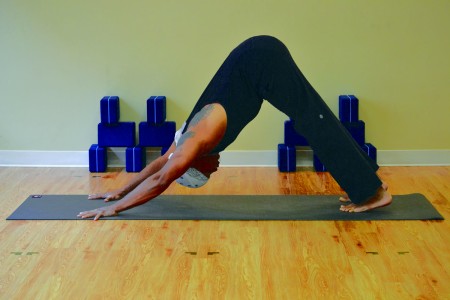
Alignment: Hands grounded shoulder width apart, fingers spread / feet 6-inches apart/ hips lift/ head drops/ gaze between the feet / 60% of body weight back in to legs / drop chest toward thigh muscles.
Body parts stretched: spine, back muscles, shoulders, hamstrings, and calves.
Body parts strengthened: arms, quadriceps, shins, core.
Benefits: With excessive back pain, the problem area starts with the hamstrings and hip rotation. Another problem area for football players is shoulders. Downward facing dog focuses on these areas and builds upper body performance. This is the one posture that I would include when only one posture can be done.
Forward Fold
(See Photo 2)
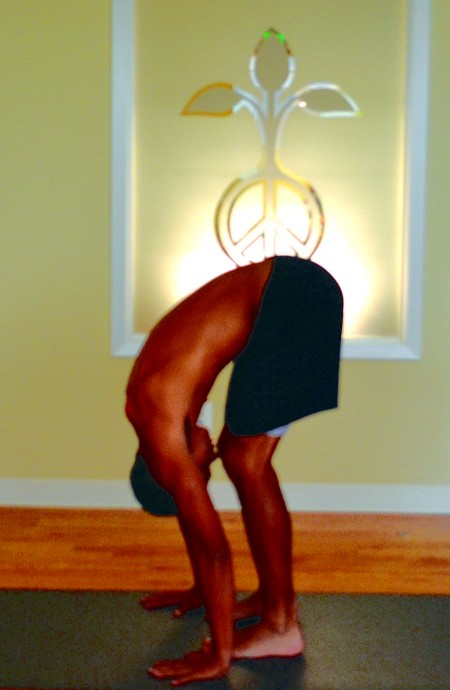
Alignment: Feet 6-inches apart / chest towards thighs / hips align over ankles.
Body parts stretched: hamstrings, calves, hips, lower back.
Body parts strengthened: quadriceps, illiotibial band, knees.
Benefits: This posture will benefit anyone. It is ideal for the beginning of any routine. It creates an opportunity to identify asymmetry and imbalances between two sides of the body.
Chair Pose
(Photo 3)
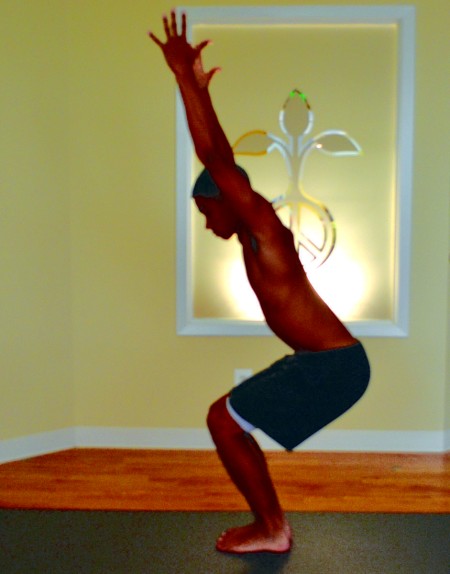
Alignment: Big toes touch / bend knees / knees behind the toes / drop hips / arms straight and lifted up just outside of ears / gaze foreword.
Body parts stretched: shoulder, chest, calves.
Body parts strengthened: quadriceps, shins, glutes, spine, lower back and ankles.
Benefits: When in this pose, you will challenge your core and eliminate excess stress on the abdomen while building strength in the legs. While in this pose players will stimulate the heart and the diaphragm.
Warrior I
(Photo 4)
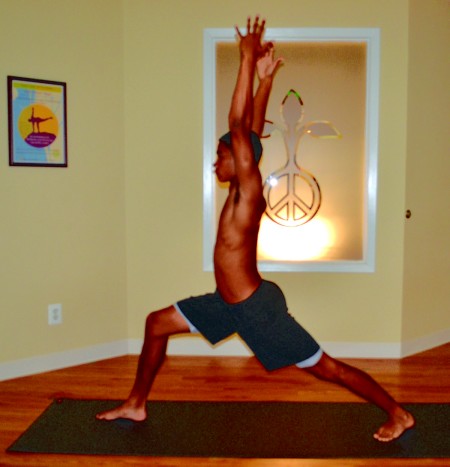
Alignment: Front foot forward, back foot 45 degrees forward / seal into outer edge of back foot / sink into front leg by bending the knee over the ankle / 90 degree bend in front leg / hips close to the front of the room / chest faces forward over front leg, aligned with direction of hips / arms reach over head.
Body parts stretched: biceps, groin, chest, lower back.
Body parts strengthened: quadriceps, feet, trapezius, triceps.
Benefits: Although you are still in this posture, the pose suggests disciplined muscle energy to remain still with strength. You will experience an increased sense of body awareness, coordination, and focus.
Warrior II
(Photo 5)
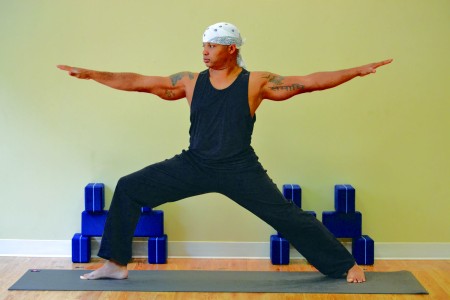
Alignment: Front foot forward, back foot almost parallel to back of the mat / seal into outer edge of back foot / sink into front leg by bending the knee over the ankle / 90 degree bend in front leg / hips open / chest opens with hips / arms parallel to the ground and in line over the legs / bring gaze over front hand.
Body parts stretched: biceps, hips, groin, chest, neck, back, ankle.
Body parts strengthened: shoulders, quadricep, trapezius, triceps, core.
Benefits: This posture challenges the body. Shoulder, hips and knees will be challenged and strength will increase for stability. The increase in stability will ultimately aid the body in handling high impact in competition.
Crescent Lunge
(Photo 6)
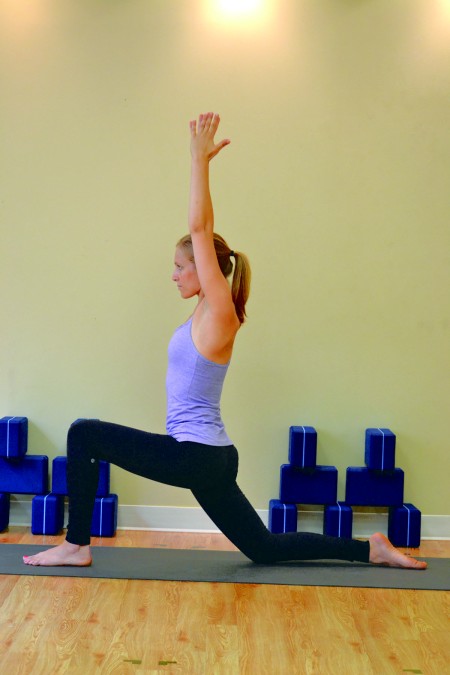
Alignment: All the toes point forward / back heel lifted / bend front knee / shoulders align over hips / arms lift straight up as if in Warrior I (option is to drop the back knee).
Body parts stretched: groin, hip flexor, shoulders, lower back, back calf muscle.
Body parts strengthened: trapezius, quadriceps, hamstring, front calf muscle, triceps.
Benefits: Increases balance, poise and power that are generated throughout the effort of finding balance.
Dancer
(Photo 7)
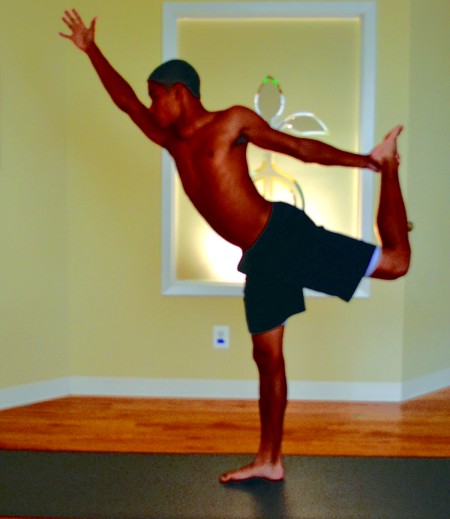
Alignment: Hands catch the same-side ankle / straighten standing leg / kick back into hand and reach opposite arm and upper body foreword / continue kicking leg up.
Body parts stretched: hip flexor, quadriceps, hamstring spines, arms, and shoulders.
Body parts strengthened: hip flexor, quadriceps, hamstring, feet.
Benefits: In this full-body flexibility posture, players will begin to find the balance between staying poised and reaching for more. Finding strength in the post-up leg and creating ease in the lifted leg, players will further their awareness of the power accessed through ease in their mind and body.
Tree
(Photo 8)
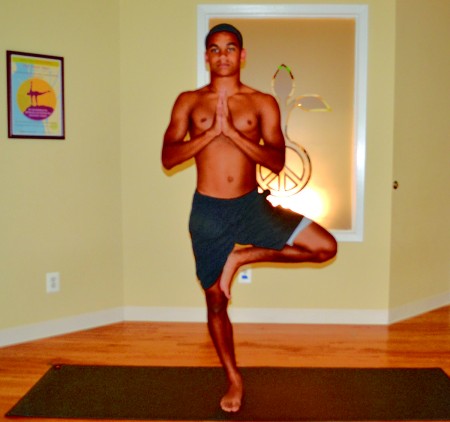
Alignment: Standing foot grounded / sole of other foot rooted into inside of standing leg (knee remains untouched and open) / bent knee opens, keeping hips open and aligned foreword / shoulders relax / fingers interlaced and palms pressing straight up to the ceiling.
Body parts stretched: groin, inner thighs, chest, shoulders.
Body parts strengthened: thighs, calves, ankles, spine.
Benefits: While in this posture, there is improvement in a total sense of balance. With the use of cleats, this posture is important and it reduces the risk of fallen arches while helping with flat feet. There is extended reach through spanning the back and upper body.
Triangle
(Photo 9)
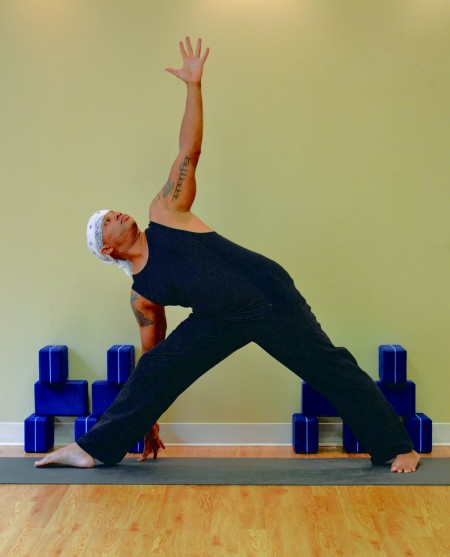
Alignment: Feet align as in Warrior II / both legs straight / hips open as in Warrior II / front hand is down, top arm reaching straight up / crown of head reaching foreword
Body parts stretched: hips, groin, hamstrings, calves, shoulders, chest, spine, side waist muscles.
Body parts strengthened: thighs, knees, ankles, side waist muscles.
Benefits: This position relieves the effects of flat feet, while decreasing neck pain.
Bridge
(Photo 10)
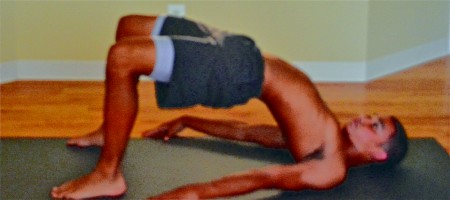
Alignment: On the back / bend knees /shoulders on the ground with arms and shoulders walking under the back / lift chest towards chin,.
Body Parts Stretched: neck, back, spine hips, chest torso.
Body Parts Strengthened: Quadriceps, glutes, hamstrings, back and abdomen.
Benefits: Helps to bring ease to the inner costal muscles. By stretching the muscles around the rib cage, the athlete will find an increase in breathing capacity. Flexibility in the spine creates more energy for a faster recovery. p
About the Author: Sid McNairy is the founder and owner of the Sid Yoga Center in Towson, Maryland. He is a former coach at Northern Illinois and holds a Bachelor’s Degree from Purdue and a Master’s from Eastern Illinois. He can be reached at www.SidYoga.com.
Deep Rest
Alignment: On back / body completely relaxed; back of neck to the ground with chin naturally down / arms extended away from the hips slightly /with palms facing up / legs open several inches apart.
Benefits: This posture will create an overall effect of relaxation on the body. Players will also find that this posture will calm the brain and help to relieve stress. You will find a focus to create clarity, decisiveness, and success on the field.
Sign Up for the Play of the Week Newsletter

STRENGTH & CONDITIONING VIDEOS


Subscribe
Login
Renew
Change Address
Customer service